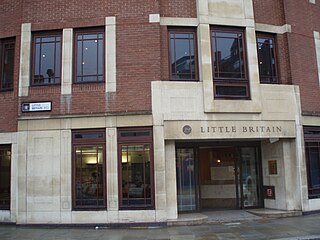
The Hail Mary or Angelical salutation is a traditional Christian prayer addressing Mary, the mother of Jesus. The prayer is based on two biblical passages featured in the Gospel of Luke: the Angel Gabriel's visit to Mary and Mary's subsequent visit to Elisabeth, the mother of John the Baptist. It is also called Angelical salutation as the prayer is based on the Archangel Gabriel's words to Mary. The Hail Mary is a prayer of praise for and of petition to Mary, regarded as the Theotokos. Since the 16th century, the version of the prayer used in the Catholic Church closes with an appeal for her intercession. The prayer takes different forms in various traditions and has often been set to music.

Ludgate Hill is a street and surrounding area, on a small hill in the City of London, England. The street passes through the former site of Ludgate, a city gate that was demolished – along with a gaol attached to it – in 1760.
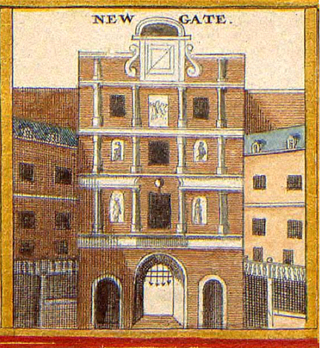
Newgate was one of the historic seven gates of the London Wall around the City of London and one of the six which date back to Roman times. Newgate lay on the west side of the wall and the road issuing from it headed over the River Fleet to Middlesex and western England. Beginning in the 12th century, parts of the gate buildings were used as a gaol, which later developed into Newgate Prison.
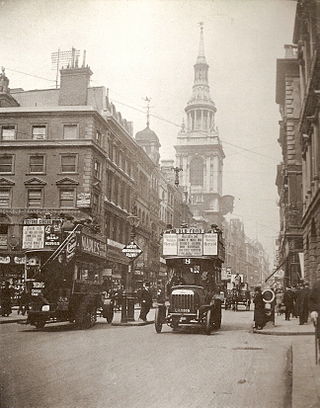
Cheapside is a street in the City of London, the historic and modern financial centre of London, England, which forms part of the A40 London to Fishguard road. It links St. Martin's Le Grand with Poultry. Near its eastern end at Bank junction, where it becomes Poultry, is Mansion House, the Bank of England, and Bank station. To the west is St. Paul's Cathedral, St Paul's tube station and square.
"Ave verum corpus" is a short Eucharistic chant that has been set to music by many composers. It dates to the 13th century, first recorded in a central Italian Franciscan manuscript. A Reichenau manuscript of the 14th century attributes it to Pope Innocent
The EC postcode area, also known as the London EC postal area, is a group of postcode districts in central London, England. It includes almost all of the City of London and parts of the London boroughs of Islington, Camden, Hackney, Tower Hamlets and Westminster. The area covered is of very high density development. Deliveries for the EC postcode area are made from Mount Pleasant Mail Centre.

The Second Great Fire of London in December 1940 was caused by one of the most destructive air raids of the Blitz during World War II. The Luftwaffe raid caused fires over an area greater than that of the Great Fire of London in 1666, leading one American correspondent to say in a cable to his office that "The second Great Fire of London has begun". Fires started by the raid included an incendiary bomb that broke through the dome of St Paul's Cathedral, which was being guarded by a fire watch team at the behest of the Prime Minister Winston Churchill.

St James Garlickhythe is a Church of England parish church in Vintry ward of the City of London, nicknamed "Wren's lantern" owing to its profusion of windows.

Paternoster Row was a street in the City of London that was a centre of the London publishing trade, with booksellers operating from the street. Paternoster Row was described as "almost synonymous" with the book trade. It was part of an area called St Paul's Churchyard.

St Michael Paternoster Royal is a church in the City of London. The original building, which was first recorded in the 13th century, was destroyed in the Great Fire of London in 1666. The church was rebuilt under the aegis of Sir Christopher Wren. However St Michael's was severely damaged during the London Blitz in the Second World War. It was restored between 1966 and 1968.

Foster Lane is a short street within Cheap ward, in the City of London, England. It is situated northeast of St Paul's Cathedral and runs southbound Gresham Street to Cheapside.
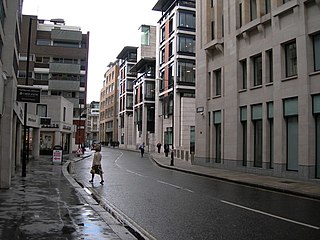
Ave Maria Lane is a street in the City of London, to the west of St. Paul's Cathedral. It is the southern extension of Warwick Lane, between Amen Corner and Ludgate Hill.

St Michael-le-Querne, also called St Michael ad Bladum, was a parish church in the Farringdon Within Ward in the City of London. It was destroyed in the Great Fire of London of 1666 and not rebuilt. The name is apparently a reference to a quern-stone as there was a corn market in the churchyard.
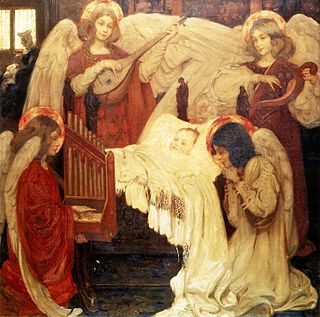
"Matthew, Mark, Luke and John", also known as the "Black Paternoster", is an English children's bedtime prayer and nursery rhyme. It has a Roud Folk Song Index number of 1704. It may have origins in ancient Babylonian prayers and was being used in a Christian version in late Medieval Germany. The earliest extant version in English can be traced to the mid-sixteenth century. It was mentioned by English Protestant writers as a "popish" or magical charm. It is related to other prayers, including a "Green" and "White Paternoster", which can be traced to late Medieval England and with which it is often confused. It has been the inspiration for a number of literary works by figures including Henry Wadsworth Longfellow and musical works by figures such as Gustav Holst. It has been the subject of alternative versions and satires.
Simeon Fox, M.D. (1568–1642) was an English physician, who became President of the College of Physicians.

The Locomotive Publishing Company was an English publishing house, specialising in railway topics. It was noted for publishing Locomotive Magazine, amongst many other highly regarded titles. It was also notable as one of the first stock photo libraries, in this case specialising in railway images.

The Oxford Arms in Warwick Lane was one of the last surviving galleried coaching inns in London. It stood near St Paul's Cathedral between the 17th and late 19th centuries.

Paternoster Vents, sometimes referred to as simply Vents and also known as Angel's Wings, is an outdoor 2002 stainless steel sculpture by Thomas Heatherwick, installed on the west side of the Paternoster Square development in London, United Kingdom, close to the junction of Warwick Lane and Ave Maria Lane with Amen Corner. The sculpture provides ventilation for an underground electrical substation.










